DOMINICAN REPUBLIC - Scouting Trip Report - June 2015
© 2015 Callyn Yorke
The Southwest
Caribbean Flamingo (Phoenicopterus ruber) Laguna Oviedo, Pedernales, Dominican Republic 16 June 2015
 © 2015 Callyn Yorke
© 2015 Callyn Yorke
While in Santo Domingo, we contacted a nature tour company, Ecotours Barahona, for information about the relatively remote southwestern section DR. The director, Nico and his business partner, Julia, of DomRep Tours, arranged an itinerary for us that would include six days in southwestern DR and ten days on the Samana Peninsula in northeastern DR (see maps below).
Maps showing the locations we visited in the southwestern portion of the Dominican Republic, June 11-17, 2015
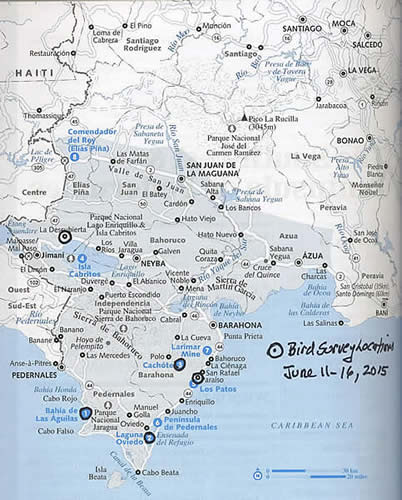
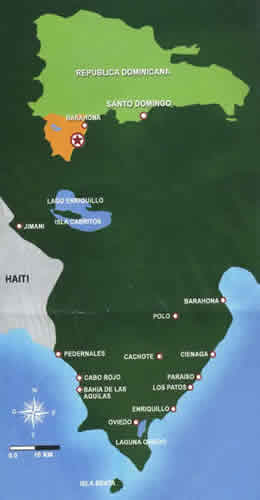
© 2014 Lonely Planet Dominican Republic, 6th edition, p. 184 © 2015 Ecotour Barahona
All of the information I could find on the natural history of DR indicated that the southwestern portion of the country held the greatest number of endemic plants and animals. The decision to go there directly from Santo Domingo was a no-brainer. So we set off by bus from Santo Domingo to Barahona on June 11, 2015, with fine weather, scenery and little traffic. Our air-conditioned, CaribeTours bus was fully equipped with reclining seats, music, tv and a toilet. I counted only seven other people traveling with us from the central bus station in Santo Domingo. We passed through a few small towns, e.g. San Cristobal, where Rafael Trujillo built a palace for he and his wife but never spent a single night there. The lavish home is now a museum (currently closed) containing exhibits of his brutalities, e.g. the massacre of tens of thousands of Haitians in October, 1937.
Much of the bus route west of Santo Domingo traversed rolling hills of unihabited cactus-thorn scrub resembling the Sonoran Desert of northwestern Mexico. Here, in the rainshadow of the Cordillera Central, which includes Pico Duarte (3087 m), the highest peak in the Caribbean , the climate abruptly changes from warm and humid to hot and dry. Only the coastal mountains and higher interior elevations support forested watersheds and villages with subsistence agriculture; most of the interior lowlands from Barahona to Pedernales are parched and sparsely inhabited. Moreover, elevational changes and associated life zones support an extremely varied flora and fauna; most of the Hispaniolan endemic species are found in this region.
Lago Enriquillo National Park, southwestern Dominican Republic June 13, 2015

© 2015 Merissa Mendez
One of Nico's associates met us in Barahona, a trash-ridden frontier town serving as the gateway to the southwest. We were transported by SUV to Rancho Don Cesar adjacent to the village of Paraiso. The scenery between Barahona and Paraiso changed dramatically once again. Hugging the scenic cliffs overlooking miles of deserted beaches, were remnants of a lush coastal rainforest (photo).
Scenery along the coastal road between Barahona and Paraiso, southwestern Dominican Republic June 15, 2015
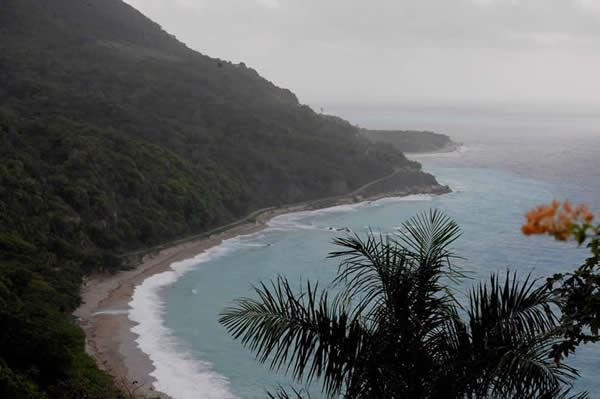
© 2015 Callyn Yorke
La Cienaga, north of Paraiso, DR 15 June 2015
© 2015 Merissa Mendez
Rancho Don Cesar turned out to be a delightful home base for a series of day-excursions with bi-lingual guides from Barahona Eco-tours. We settled into a spacious second-story room overlooking a riverine forest. The rancho, including several hundred acres of undeveloped land, had been a family heirloom and was recently converted into an attractive tourist resort. Indeed, had Nico not mentioned it, we would have missed it completely, since the place was fairly remote and not mentioned in the latest (2014) Lonely Planet guidebook. Rancho Don Cesar was perfect for us. A clean, comfortable room, good food, friendly service, adjacent trails for nature walks and good birding. Except for three other tourists spending only one or two nights, we were the principal guests. Our biggest complaint was that a six-day stay there was too brief. We also regretted missing the mysterious owner, Don Cesar, who was reportedly abroad on business, presumably befitting the world's most interesting man.
Rancho Don Cesar, Paraiso, Dominican Republic June 12, 2015
© 2015 Merissa Mendez
Riverine forest, Rancho Don Cesar, Paraiso, Dominican Republic 13 June 2015
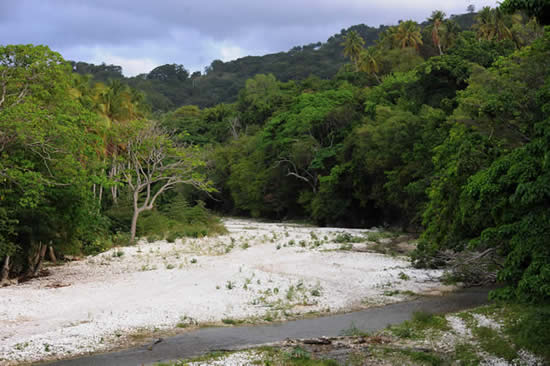
© 2015 Callyn Yorke
The morning after our arrival at Rancho Don Cesar we headed south from Paraiso along a scenic coastal route, stopping briefly in the village of Enriquillo (an agricultural village with the region's only wind farm and 24/7 electricity) then after about another thirty-minutes of driving, we were on the eastern shore of Laguna de Oviedo. This stop was brief but gave promising views of waterbirds in the distance, including Caribbean Flamingo and Magnificent Frigatebird. Our Barahona tour guide, Wendy, a six-foot three Dominican man with a 96-mph fast ball, agreed that we might change our itinerary later in the week to include a boat trip on the lake. Meanwhile, we still had another hour drive to our main destination.
Magnificent Frigatebird flying over the Eastern shore of Laguna de Oviedo, southwestern DR 12 June 2015
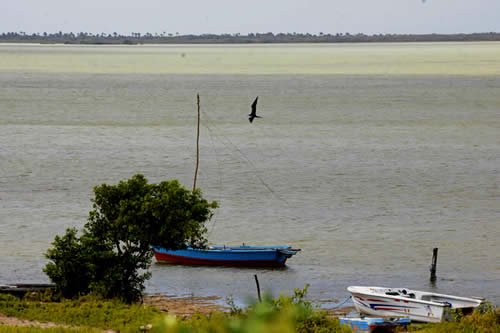
© 2015 Callyn Yorke
Continuing on the coastal highway, we skirted one of the largest national parks in the DR, Jaragua. Virtually all of this remote park consisted of rolling hills of cactus-thorn scrub, similar to what we saw for many miles heading west of Santo Domingo. The difference was, after about an hour of bouncing around on dusty roads, stunning coral sand beaches, scenic cliffs and calm seas of multiple hues of blue and green: Welcome to the village of Bahia de las Aguilas. We hired a small fishing boat for a 15-minute ride to an even more remote section of the beach, where Wendy, Merissa and I spent several hours swimming and enjoying the pristine environment.
Paradise is never perfect and a potentially serious problem had developed. I had accidentally dunked part of my camera in the sea when exiting the fishing boat. The result was the immediate failure of my image monitoring system. Most everything else on the water-resistant Nikon D3x and 80-400mm lens seemed to work okay; I just couldn't review the images until I returned to our room and a computer monitor. This rather minor inconvenience caused me to reflect on the fact that it wasn't too many years ago photographers waited several days or more to see the results of their work. Its amazing how we are so easily accustomed to modern technology. Then the auto-focus system failed, followed by the electronic lens-to-camera coupling. It seemed as though the salt water had targeted the time-saving functions, essentially reducing the camera to a vintage 1965 Nikon SLR. Luckily, those malfunctions were the worst of it and the equipment otherwise continued to function fairly well during the remainder of our trip. Merissa still had her rugged, Kodak point-and-shoot (her iPad was water-compromised a few days later by a leaky water bottle in her back-pack). Note to self: Water bad for digital camera; travel with back-up.
Fishing village adjacent to Bahia de las Aguilas, southwestern DR, 12 June 2015
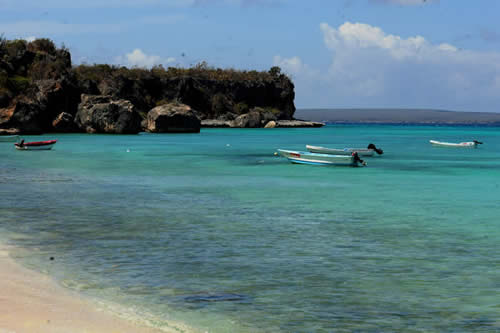
© 2015 Callyn Yorke
Aside from fly-bys from a Laughing Gull, Magnificent Frigatebird and Cave Swallow - the latter a regional specialty, our three-hour visit to Bahia de las Aguilas produced little of zoological interest. Even the shallow, warm waters appeared largely devoid of fish. About 100 yards off-shore was a coral reef, but it was a bit of swim to reach it and the afternoon winds were picking up, putting a chop on the bay. So we simply relaxed and enjoyed the unsurpassed beauty of the place. In retrospect, Bahia de las Aguilas was the most spectacular, unspoiled coastal location we encountered during our travels in the DR.
The return trip from the Bahia de las Aguilas village to the nearby port of Cabo Rojo allowed us time for a brief stop at a small roadside marsh. There were numerous waterbirds in the marsh, including at least one species we would not encounter elsewhere in DR, e.g. Greater Yellowlegs. This little marsh was apparently well-known to professional birding groups (e.g. Wings) and was reportedly one of the most productive locations for wintering waterbirds in the region. Evidently, the marsh also attracts a number of summering birds, so it was well worth our brief visit.
LAGO ENRIQUILLO
North shore of Lago Enriquillo near La Descubierta, DR 13 June 2015
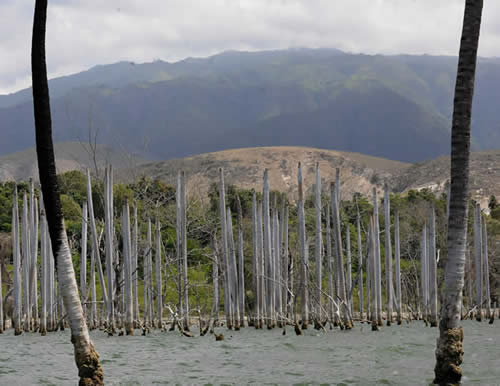
© 2015 Callyn Yorke
June 13, 2015 -- We drove with Giovanni, our Barahona Ecotours guide, for about 2.5 hours from Paraiso to the Lago Enriquillo park entrance, about 3km east of the town of La Descubierta. It was already nearly noon and hot enough (90 F) for several tomcat-sized Rhinoceros Iguanas to seek the sparse shade of a cluster of thorny mesquite trees.
I spent a few minutes trying to interpret several posters (in Spanish) describing the geology and natural history of the lake. Here's what I learned: Lago Enriquillo, the largest lake in the Caribbean, is essentially similar to the Salton Sea of southern California. Both of these basins resulted from geologic subsidence and adjacent uplift, eventually filling with water (the Salton Sea formed because of a breach in an irrigation canal) and becoming landlocked without any outlets. The result of former eastern and western connections with the sea (Lago Enriquillo), together with high evaporation rates, rendered these relatively shallow lakes extremely salty. Few unspecialized aquatic organisms can survive such conditions. At Lago Enriquillo, introduced Tilapia and about two-hundred American Crocodiles (the latter favoring freshwater inlets) are about the only fully aquatic vertebrates in evidence. A variety of waterbirds frequent the shallows and shore lines; we encountered some of them during our brief visit, including Caribbean Tree Duck (photo), Tricolored Heron and Black-crowned Night Heron, all new birds for our DR trip list.
The cactus-thorn scrub surrounding the park visitor center held regional endemic landbirds we did not encounter elsewhere in DR, e.g. Plain Pigeon, Stolid Flycatcher and Greater Antillean Bullfinch. Additionally, a pair of Broad-billed Todies were gleanng insects from trees near shore.
But the stars of the show were the charismatic Rhinoceros Iguanas (photo), which were so tame and numerous around the visitor center, we had to be careful not to step on them.
Caribbean Tree Duck (Dendrocygna arborea) Lago Enriquillo, DR 13 June 2015 Rhinoceros Iguana (Cyclura cornuta) Lago Enriquillo, DR 13 June 2015

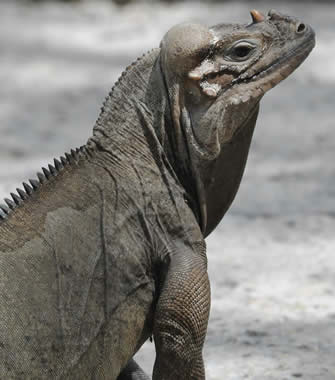
© 2015 Callyn Yorke
Ricord's Iguana (Cyclura ricordii) is a closely related species known only from two isolated populations separated by the Sierra de Baoruco in southwestern DR. One of those populations includes the north shore of Lago Enriquillo and a nearby island, Isla Cabritos. I was very excited about the opportunity to see these rare and endangered lizards during our visit. However, upon arrival, our guide Giovanni informed us that boat trips to Isla Cabritos had been canceled indefinitely due to an island research project. Since these lizards lay their eggs on the island during this time of year (May-June), and are declining due to human disturbances of their habitat, the visitation restriction may have certainly been justified.
Instead of the much anticipated trip to Isla Cabritos (which, by the way, was the only place in DR we could see the endemic Palm Crow) our consolation prize was a 40-minute open boat ride around the northern shore of Lago Enriquillo. Rising water levels due to climate change had inundated many acres of habitable land, including hundreds of palm trees and cactus thorn-scrub (photo). Apparently, many of the local residents on the lakeshore have been displaced, along with their livelihoods. A real bummer for these folks living at or below the povery line in DR. This scene was reminiscent of a recent TV documentary I watched showing Eskimos losing their homes due to melting ice.
As our motor boat dodged and weaved through a maze of dead trees and shrubs, waterbirds flushed and crocodiles slowly sank beneath the surface. The frequent turns and minor collisions made photography difficult and I managed to obtain only a couple usable images (e.g. Caribbean Tree Duck atop a decapitated palm). Then we headed back to the park headquarters at top speed in open water, whitecaps and salt spray threatening to finish off my camera.
On the return drive to Paraiso, we stopped on the north shore of Lago Enriquillo at a place called Las Caritas. A sign in Spanish indicated a tourist attraction. The items of interest were curious petroglyphs of unknown origin and significance. A steep trail led to an overhang of boulders featuring a variety of carved figures resembling elementary school artwork. Using a little imagination, we could identify some of the figures, e.g. a big scorpion (common in the region) and jack-a-lantern like faces. Some of the engravings appeared relatively recent, e.g. the letters "n" and "A." While we caught our breath studying and photographing the site, an adult Rhinoceros Iguana began climbing over the pteroglyphs, as if to underscore their antiquity (photo).
Without historcal context, petroglyphs here and elsewhere may be variously interpreted. Applying the principle of parsimony, or Occam's razor, I submit that if the Las Caritas site is partially or wholly authentic (i.e. prehistoric) then it probably represents the work of an outcast or social misfit who, like the writer portrayed by actor Jack Nicholson in the film, The Shining, had little or no interest in producing anything meaningful.
Las Caritas petroglyphs, Lago Enriquillo, DR 13 June 2015
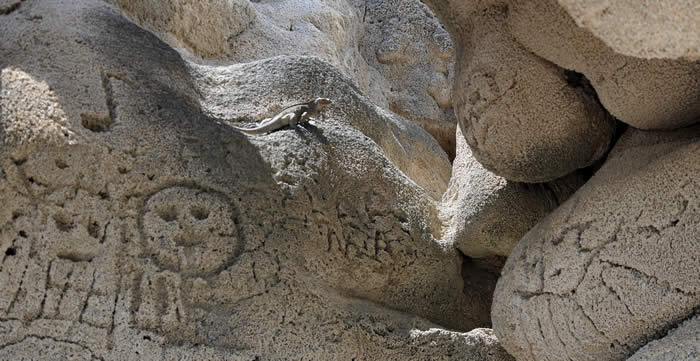
© 2015 Callyn Yorke
Cachote
Cachote forest road, Elev. 3,500 ft. DR 14 June 2015
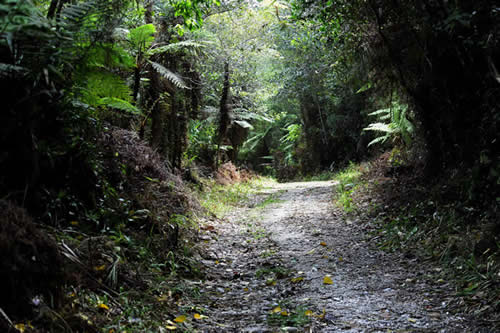
© 2015 Callyn Yorke
June 14, 2015 - Our drive to the Cachote highlands was pretty rough. Merissa and I sat in the back seat of a 4WD Nissan pickup truck.The bed was loaded with an engine-pulling A-frame and a bunch of other stuff, including a cooler with our lunch. A local friend of Franklin, our driver, had lost the A-frame out of the back of his truck on this road the previous day. We had been recruited to return it to his home somewhere in the mountains. All the way, the rusty frame slapped the roof-rack of our truck, in rythym with potholes, dips and sudden lurches forward. After about an hour of this, Franklin stopped the truck and retied the awkward load so as to insure we wouldn't lose it as well (photo). Giovanni and I took the oportunity to bird the road on foot, which wasn't much slower than the progress we had made with the truck.
Both sides of the roadway between elevations of about 1400-2,500 ft. were part of a huge coffee plantation shaded by tall rainforest trees covered with epiphytes. This relatively moist habitat comprised the lower slopes of the Sierra de Bahoruco and supported a diverse avifauna. Out of about 32 species of endemic birds on Hispaniola, 30 of them could be found in this area. Within an hour of walking and listening, we encountered nearly all the birds we would see during the rest of the day. Highlights included, the world's second smallest bird and Hispaniolan endemic, Virvain Hummingbird (a couple of grams heavier than the Cuban Bee Hummingbird)); other specialties found included, Hispaniolan Lizard Cuckoo (photo), Narrow-billed Tody (photo), numerous singing Black-whiskered Vireos and a Black-crowned Palm Tanager (photos).
Continuing our ascent on the road we reached the small village of Cachote; my altimeter read 3,700 ft. Birding in and around the village was even better than the coffee plantation. We were at the lower slopes of a cloud forest -- a transitional life zone -- which supports both montane and low-elevation birds A small flock of Hispaniolan Parakeets landed in a nearby tree; a pair of Narrow-billed Todies were gleaning insects from shrubs alongside the road (photo). The haunting song of another endemic, Rufous-throated Solitaire (photo) serenaded us for several minutes.
The Cachote visit included a tour of an ecological research station used by university classes. The hilltop setting within an undisturbed, protected cloud forest appeared ideal for student projects, such as medicinal uses of native plants, butterfly diversity, amphibian ecology, and of course, avian ecology. The facility included an outdoor lecture area, kitchen, dining and several rustic bunkhouses.
We returned to the village via a narrow, slippery trail through a dripping-wet cloud forest. At the bottom of the trail we had lunch in the home of a local family. Afterwards, our host did the dishes outside while their pig kept an eye out for food scraps (photo). Her boys were excited to show us a pair of baby birds (Black-whiskered Vireo) they had been caring for (photo).
By 2 PM we were headed down the mountain for Paraiso. I was quite pleased with our birding results and anxious to get back to Rancho Don Cesar in order to see my photos on the computer. We passed numerous folks returning from the Sunday market located several miles below Cachote; some were squeezed together in small pickup trucks, many rode small motorcycles and a few were on foot, carrying their groceries and other goods. Most of the people waved back at us; few of them were smiling.
Franklin and the Ecotour Barahona 4WD Nissan on the Cachote road, 14 June 2015

© 2015 Callyn Yorke
Cachote village life; two oldest boys holding captive juvenile Black-whiskered Vireos (Vireo altiloquus) 14 June 2015

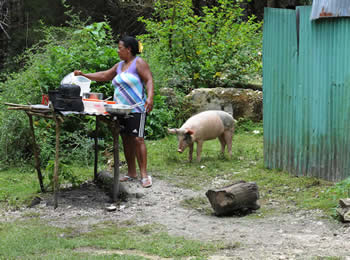
© 2015 Callyn Yorke
The author with a juvenile Black-whiskered Vireo (Vireo altiloquus) on photo-loan from the local Cachote boys, 14 June 2015

© 2015 Merissa Mendez
Merissa at one of the Cachote Ecological Research Station bunk houses One of several Educational conservation signs at Cachote ERS 14 June 2015
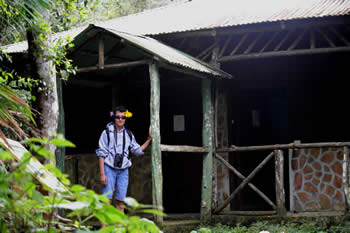
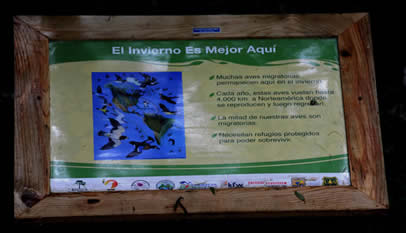
© 2015 Callyn Yorke
Narrow-billed Tody (Todus angustirostris) Cahote, DR 14 June 2015

© 2015 Callyn Yorke
Hispaniolan Lizard Cuckoo (Coccyzus longirostris) (left) and Yellow-billed Cuckoo (Coccyzus americanus), Cachote DR 14 June 2015
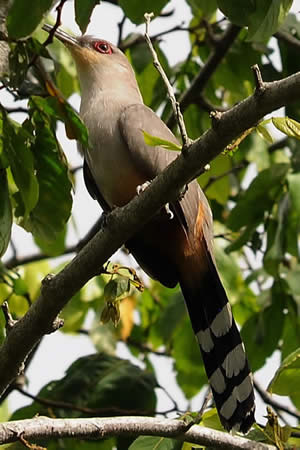

© 2015 Callyn Yorke
Rufous-throated Solitaire (Myadestes genibarbis) (left) and Black-crowned Palm Tanager (Phaenicophilus palmarum) Cachote, DR 14 June 2015

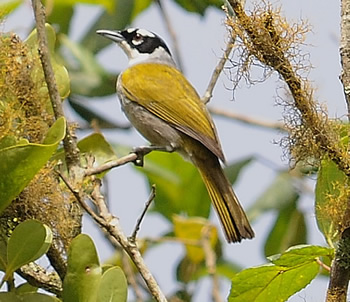
© 2015 Callyn Yorke
LAGUNA OVIEDO - June 16, 2015
West Laguna Oviedo, Pedernales, Dominican Republic 16 June 2015
© 2015 Merissa Mendez
We drove from Paraiso directly to the visitor center for the Laguna Oviedo National Park, which is part of Parque National Jaragua in the Pedernales province of southwestern DR. We had been here briefly a few days earlier but only as a rest stop en route to Bahia de las Aguilas. This morning we hired a boat to take us across the shallow, saline lake, including brief visits to heron-ibis colonies on a couple of rocky islets. Our trip on the lake also included a lunch-break on a mangrove island with an introduced population of about 300 Rhinoceros Iguana.
Before leaving on the boat trip, I walked along the shore opposite the visitor center and boat launch to observe and photograph birds. A salt crust had formed following the receding water level, allowing me to walk cautiously almost to the edge of the lake. A flock of flamingoes was foraging in the shallows, which drew me further out into the soft sediments to the point where it seemed that one more step and I would be sinking fast out of sight, waving my arms to be rescued.
I managed to stay on firm ground and click off a few shots of birds in the area, including an obliging Wilson Plover on the shore and nearly eye-level Black-necked Stilt and White Ibis cruising by; Gull-billed Least Terns hovered noisily above me. This was definitely a wildlife photographer's dream. Birds were close and cooperative, alert but seemingly unafraid of my presence. The flamingoes were still a bit far offshore for good photos. Later, when motoring across the lake in an open boat, I would have some great angles on the flamingoes.
Wilson Plover (Charadrius wilsonia) Laguna Oviedo, Pedernales DR 16 June 2015

© 2015 Callyn Yorke
Black-necked Stilt (Himantopus mexicanus) Laguna Oviedo, Pedernales DR 16 June 2015
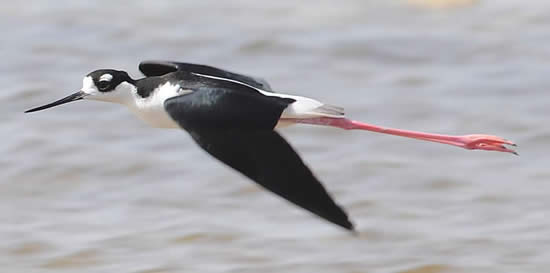
© 2015 Callyn Yorke
Gull-billed Tern (Geochelidon nilotica) Laguna Oviedo, Pedernales DR 16 June 2015

© 2015 Callyn Yorke
White Ibis (Eudocimus albus) Laguna Oviedo, Pedernales DR 16 June 2015

© 2015 Callyn Yorke
An hour or more had passed since I left Merissa, Wendy and our boat captain back at the pier. I must have walked a mile or more down the shore from them and could barely see them waving to me in the distance. Eventually, realizing I wasn't in any hury to return to the boat, they motored off in my direction. When they got to within about 100 feet from the shore it was clear the water was too shallow for the draft of the boat. They motioned for me to wade out to them. I removed my boots and socks and slogged through the soft mud, sinking to my ankles. Fortunately the ground beneath the thin layer of soft sediments was firm enough to support my weight and I made it to the boat without incident.
We set off in a westerly direction across the lake, slowing as scattered flocks of Caribbean Flamingo took notice, some struggling to become airborne. I clicked off as many shots of them as possible as Captain Yamaha slowed and accelerated, carefully maintaining a safe and reasonable distance from the birds. These magnificent creatures were graceful in almost any position, foraging, fully alert, taking flight, and cruising just above the lake. Although I had seen large flocks of flamingoes elsewhere (e.g. East Africa), Laguna Oviedo was by far the best location to observe and photograph them at close range.
Caribbean Flamingo (Phoenicopterus ruber) Laguna Oviedo, DR 16 June 2015
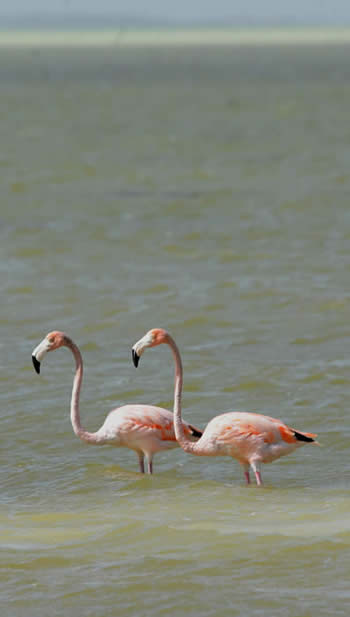
© 2015 Callyn Yorke
Caribbean Flamingo (Phoenicopterus ruber) Laguna Oviedo, Pedernales DR 16 June 2015
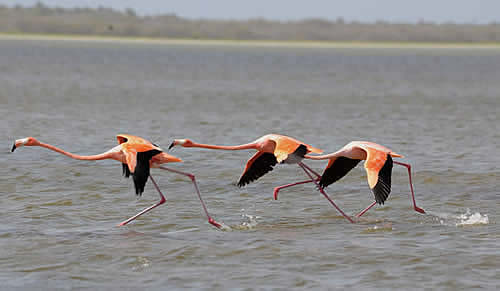
© 2015 Callyn Yorke
Caribbean Flamingo (Phoenicopterus ruber) Laguna Oviedo, Pedernales DR 16 June 2015
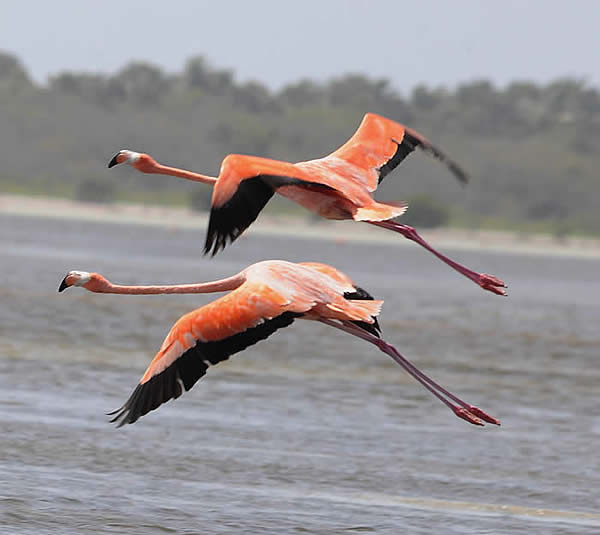
© 2015 Callyn Yorke